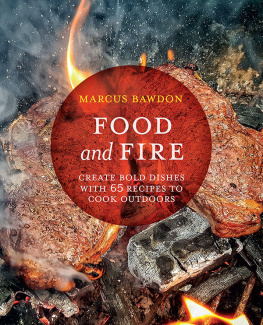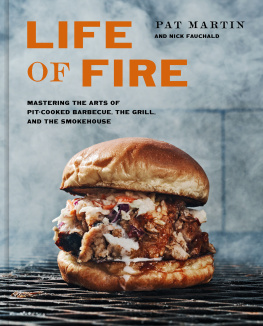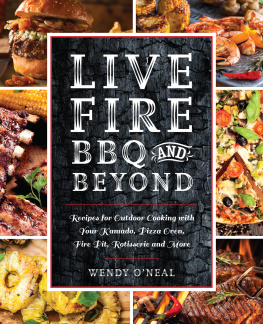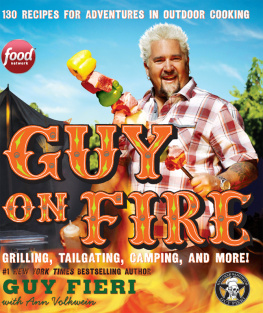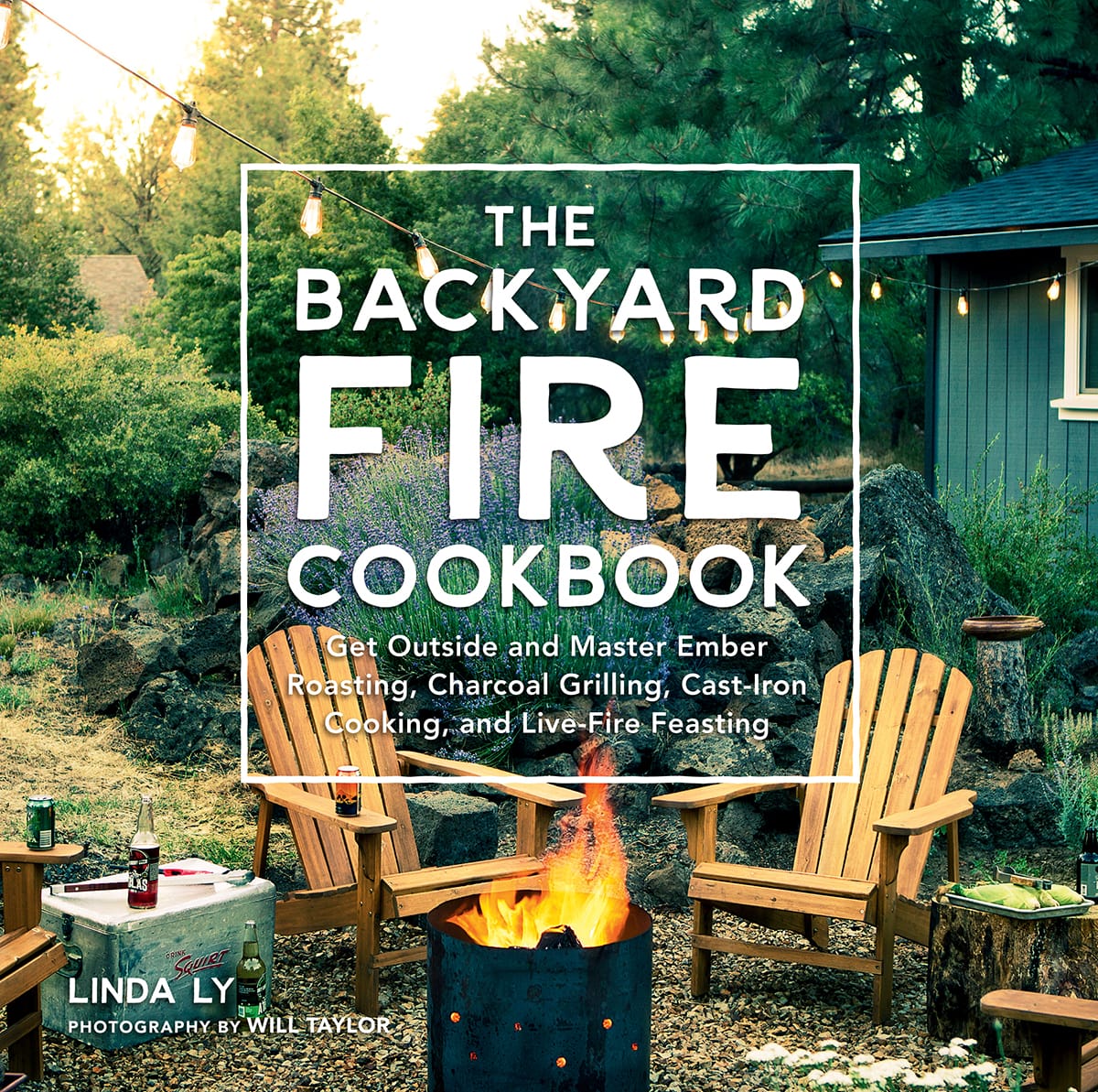THE
BACKYARD
FIRE
COOKBOOK
Get Outside and Master Ember Roasting, Charcoal Grilling, Cast-Iron Cooking, and Live-Fire Feasting
LINDA LY

INTRODUCTION
W hen I close my eyes and think of my happy place, I picture this: a canopy of conifers with a breeze whipping through, a bubbling creek, or perhaps a glassy lake, with a sublime string of peaks in the distance. Tents and coolers. Logs and embers. A hot, hearty meal shared around the fire with family and friends as the last light fades.
Its no secret I love a good campfire, but, above all, I love a great meal cooked over one. I love the leap and snap of a lively fire as it collapses into red-hot coals. I love the alchemy of sun and smoke that makes those long summer days seem even slower. I love the fact that every time you grill and gather around a fire, its a community event. You pull up your chairs, clink some cold libations, and sink into conversations that get longer and deeper as the night goes on.
It doesnt matter how simple or elaborate the meal is, or whether I charred it just a tad too much. Food just tastes better outside, and even more so when youre cooking over the one fuel that infuses its own sultry flavor: firewood.
But, as much as I love camping, I cant always get away. I can, however, get outside, even if its just a few steps from the house. So when I started thinking about how I would follow up the success of The New Camp Cookbook, it made sense to bring that kind of cooking closer to home and right into our own backyardsor front yards, or courtyards, or wherever we can carve out space for a fire.
When it comes to grilling, Im all about live fire. Theres a visceral appeal to cooking over woodthink hissing steaks on a bed of smoldering, glowing red coalsthat a gas stove and even a gas grill cant match. Its a rugged thrill thats been embedded in our culinary DNA since our human forebears discovered how to put food to flame. If youve ever had the primal exhilarationnot to mention the gustatory pleasureof roasting a marshmallow or hot dog over an open flame, then you know.
With a live fire, youre not just turning a knob to medium-high and waiting patiently for your food to brown. Youre not merely cookingyoure conducting: feeding the flames, moving the coals, or fine-tuning the vents, guiding the grill to a perfect harmony of char and smoke.
The dynamic element of grilling forces you to embrace the experience. Its food that has a beginning, a middle, and an end. You have to slow down, engage your senses, and sometimes improvise the way you cook. At the same time, you expecteven welcomethe imperfections because its those extra bits of burnt-on crust and deeply caramelized flavors that add complexity and depth. The volatile nature of cooking over fire means your food will never come out exactly like the last time, and that makes it all the more intriguing.
What you can be sure of, however, is the way grilling elevates ordinary meals into feasts that feel far more special. Grilling intensifies the natural sweetness of fruits and vegetables and turns meat into a magical blend of molten fat and juicy protein. It seasons food with the flavor of the outdoors, even if you happen to be grilling in the middle of the city.
In this book, youre not going to find low and slow barbecue or overnight brines, or whole animals tied to iron crosses or spinning on a spit. These are recipes you can make on those low-key nights when you just want to sit in the backyard with a drink in hand, enjoying the colors of a softening sky and the smells of good food sizzling on the grill.
Outside of a campsite, that is my happy placeand I hope its yours as well.
CHAPTER 1
GETTING STARTED
Cooking over a live fire may feel primordial, but modern advances in grilling technology make it easier than ever to turn out a great meal over an open flame. Whether youre just getting started with outdoor cooking or youre upgrading your backyard setup, the good news is that live-fire cooking doesnt require a lot of expensive equipment. The not-really-bad news is: All of the options available on the market can be mind-boggling.
If youre starting from scratch, Ill break down what you need to outfit your backyard kitchen, stock your pantry, and build a proper cooking fire. With some basic gear in your grilling arsenal, a little know-how, and lots of practice (dinner parties and BBQs just because!), you can master the flames and make delicious food without making a big production out of it.
COMMON TYPES OF LIVE-FIRE COOKING AT HOME
Open Fire Pit
Before there were grills, there were campfires. This primal method of cooking is thrilling and beautiful in its simplicity. It can be dug into the earth or encircled with rocks, bricks, or metal rings to contain the flames. Open fire pits are conducive to ember roasting and direct grilling, with or without a grate.
Pros: Easy to DIY and adaptable to any budget. Building your own fire pit (see ) also gives you the freedom to make it as large as you need.
Cons: Fire pits generally require a sizable amount of open space to build, and special finishes and accessories can easily inflate the overall cost.
Vessel Fire Pit
This is the type of fire pit youll find in most backyards. The contemporary design contains the fire in a bowl, trough, or other vessel, and its main purpose is to provide heat. However, some manufacturers offer add-ons that include cooking grates, warming racks, and rotisserie systems to turn backyard fire pits into instant grilling stations.
Pros: Fast setup and suitable for small spaces. With a wide variety of designs, these fire pits are also attractive enough to blend into their surroundings.
Cons: Because vessel fire pits typically arent intended for cooking, they may be less than stable when grilling attachments are added, or too small to cook for a crowd.
Open Grill
The simplest of all grills, an open grill is a metal or stone box with burning wood or charcoal at the bottom. The food is placed over the fire with or without a cooking grate. Open grills include tabletop and table grills and Japanese hibachi. Theyre ideal for high-heat direct grilling and quick-cooking foods, which cover the majority of what people typically grill at home.
Pros: Easy enough for anyone to start grilling without a large learning curve. Smaller models are portable enough to travel with you.


